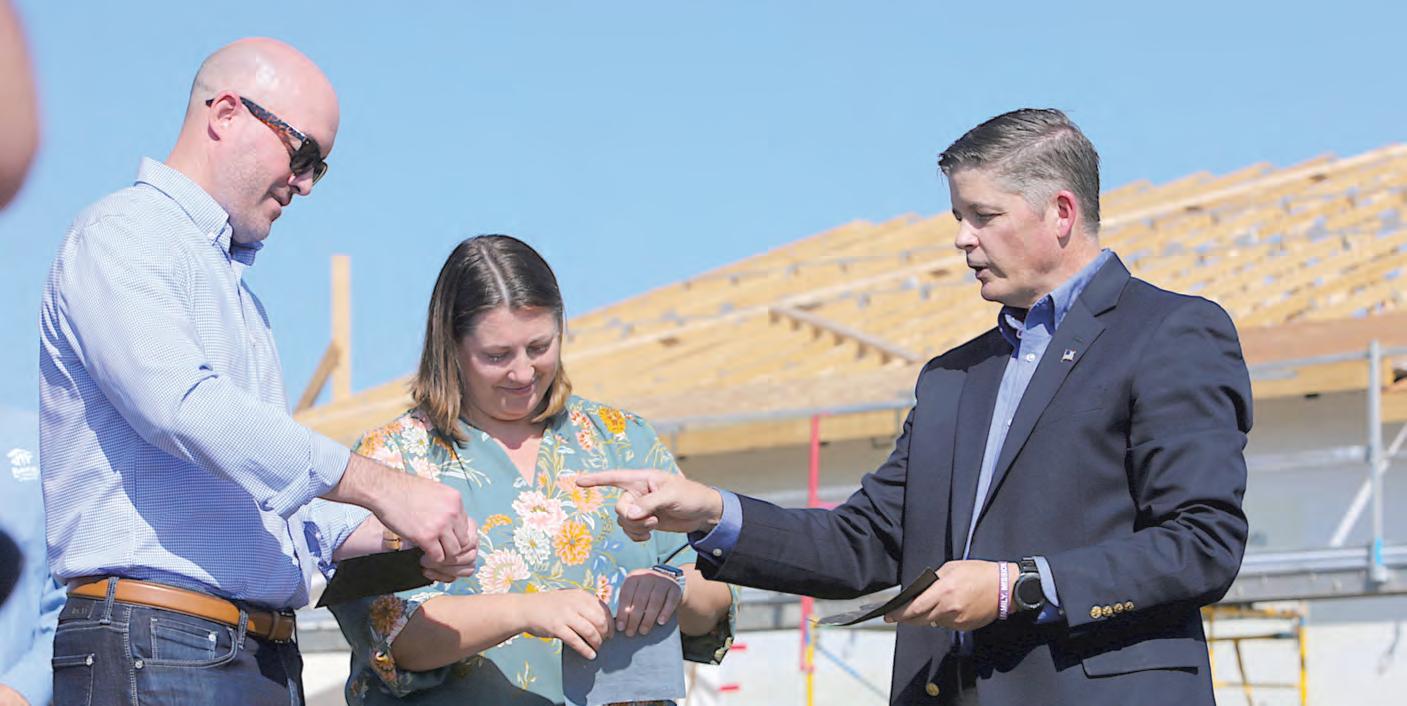
4 minute read
Building better homes
Wisconsin Insurance Commissioner, left, and Grace Arnold, Minnesota Commerce Commissioner, center, examine materials that are used to make a roof more resistant to storm damage as Fred Malik, vice president of the fortified building programs at the Insurance Institute for Business & Home Safety, explains the items. The three were on site of a Habitat for Humanity Serving Winona County home in St. Charles Monday, Aug. 28, 2023. John Molseed / Post Bulletin
New Minnesota law incentivizes construction that stands up to climate change
John Molseed | Post Bulletin
ST. CHARLES, Minn. — Among the figurative whirlwind of legislation passed by a DFL-controlled Minnesota Legislature was an initiative intended to protect Minnesota homes from literal whirlwinds and worse.
The Strengthen Minnesota Homes legislation passed in 2023 sets up a grant
program to help homeowners and builders bridge the gap between meeting minimum building standards and making buildings more resistant to storm damage.
The program is still in its planning stages. Some state leaders working to implement it toured a construction site in St. Charles, Minnesota, Monday to see a home under construction by Habitat for Humanity. The building, once completed, will likely meet insurance standards as a “fortified” home and qualify the owners for insurance breaks under programs Strengthen Minnesota Homes was modeled after.
Grace Arnold, Minnesota Commerce Commissioner, was at the site. Arnold said Minnesota is consistently a top state for wind and hail storm damage insurance claims.
Fred Malik, vice president of the fortified building programs at the Insurance Institute for Business & Home Safety, demonstrated materials and items builders will use to construct the roof. On their own, they don’t look out of the ordinary. Materials include ring shank nails, sealant tape, stronger sealant material and capped nails to secure the sealant material. However, the items almost double the bare minimum $750 roof costs of the duplex, according to John Corcoran, director of operations and construction at Habitat for Humanity Serving Winona County.
Still, he added, “That’s nothing compared to a natural disaster.”
Malik noted similar programs have been set up in Gulf Coast and West Coast states. Alabama has
a grant program that pays builders or homeowners for the difference in construction costs between minimum standards and the IIB&HS construction materials and standards. However, the concept hadn’t caught on in the Midwest yet until Minnesota’s introductory legislation.
“Wind is wind and rain is rain,” Malik said. “At this scale, they don’t really behave any differently.”
Minnesota isn’t the only state exploring incorporating storm resiliency into construction incentives. Nathan Houdek, Wisconsin Insurance Commissioner and Dan Hereth, Secretary of the Department of Safety and Professional Services, joined the tour to learn about Minnesota’s new program in planning one of their own.
“When we experience ever greater number and stronger storms, we need to think beyond minimum standards,” Hereth said.
In its first year, Strengthen Minnesota Homes has $1 million in funding to get set up the staff and framework for a grant program to be implemented later.
Although the program will be ironed out later, Corcoran said he opted for higher standards for the Habitat for Humanity home because it’s a long-term cost savings even without the grant.
Becca Seidel, deputy executive director of Habitat for Humanity of Minnesota, who visited the site, said she was glad to see the technique put to use on a Habitat house for multiple reasons. The owners who move in will likely see lower insurance costs in the future and the home will hold more value with its resiliency.
“We don’t want the houses we build now to be the poverty housing of the future,” she said.
It’s part of Habitat for Humanity’s longterm approach to building, said Jeremy Beier, sustainable building director for Habitat for Humanity Minnesota.







